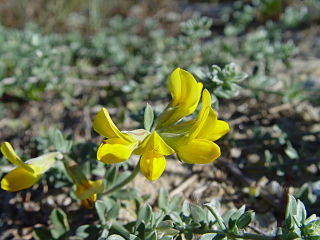
Calcium (Ca) deficiency is a plant disorder that can be caused by insufficient level of biologically available calcium in the growing medium, but is more frequently a product of low transpiration of the whole plant or more commonly the affected tissue. Plants are susceptible to such localized calcium deficiencies in low or non-transpiring tissues because calcium is not transported in the phloem. This may be due to water shortages, which slow the transportation of calcium to the plant, poor uptake of calcium through the stem, or too much nitrogen in the soil.

Cornus florida, the flowering dogwood, is a species of flowering tree in the family Cornaceae native to eastern North America and northern Mexico. An endemic population once spanned from southernmost coastal Maine south to northern Florida and west to the Mississippi River. The tree is commonly planted as an ornamental in residential and public areas because of its showy bracts and interesting bark structure.

Vegetative reproduction is any form of asexual reproduction occurring in plants in which a new plant grows from a fragment or cutting of the parent plant or specialized reproductive structures, which are sometimes called vegetative propagules.

Auxins are a class of plant hormones with some morphogen-like characteristics. Auxins play a cardinal role in coordination of many growth and behavioral processes in plant life cycles and are essential for plant body development. The Dutch biologist Frits Warmolt Went first described auxins and their role in plant growth in the 1920s. Kenneth V. Thimann became the first to isolate one of these phytohormones and to determine its chemical structure as indole-3-acetic acid (IAA). Went and Thimann co-authored a book on plant hormones, Phytohormones, in 1937.

Calabaza is the generic name in the Spanish language for any type of winter squash. Within an English-language context it specifically refers to what is also known as the West Indian pumpkin, a winter squash typically grown in the West Indies, tropical America, and the Philippines. Calabaza is the common name for Cucurbita moschata in Cuba, Florida, Puerto Rico, and the Philippines. C. moschata is also known as auyama in Colombia, the Dominican Republic and Venezuela; ayote in Mexico and Central America; zapallo in certain countries of South America; and "pumpkin", "squash", or "calabash" in English-speaking islands.

Floriculture is the study of the efficient production of the plants that produce showy, colorful flowers and foliage for human enjoyment and the human environment. It is a commercially successful branch of horticulture and agriculture found throughout the world. Efficient production practices have been developed over the years, for the hundreds of plant taxa used in the floral industry, increasing the overall knowledge of whole plant biology. Plant breeding and selection have produced tens of thousands of new genotypes for human use.

Waratah (Telopea) is an Australian-endemic genus of five species of large shrubs or small trees, native to the southeastern parts of Australia. The best-known species in this genus is Telopea speciosissima, which has bright red flowers and is the New South Wales (NSW) state emblem. The waratah is a member of the family Proteaceae, flowering plants distributed in the Southern Hemisphere. The key diagnostic feature of Proteaceae is the inflorescence, which is often very large, brightly coloured and showy, consisting of many small flowers densely packed into a compact head or spike. Species of waratah boast such inflorescences ranging from 6–15 cm in diameter with a basal ring of coloured bracts. The leaves are spirally arranged, 10–20 cm long and 2–3 cm broad with entire or serrated margins. The name waratah comes from the Eora Aboriginal people, the pre-European inhabitants of the Sydney area.

Citrullus colocynthis, with many common names including Abu Jahl's melon,colocynth, bitter apple, bitter cucumber, egusi, vine of Sodom, or wild gourd, is a desert viny plant native to the Mediterranean Basin and Asia, especially Turkey, and Nubia.

A plant cutting is a piece of a plant that is used in horticulture for vegetative (asexual) propagation. A piece of the stem or root of the source plant is placed in a suitable medium such as moist soil. If the conditions are suitable, the plant piece will begin to grow as a new plant independent of the parent, a process known as striking. A stem cutting produces new roots, and a root cutting produces new stems. Some plants can be grown from leaf pieces, called leaf cuttings, which produce both stems and roots. The scions used in grafting are also called cuttings.

Indole-3-butyric acid (1H-indole-3-butanoic acid, IBA) is a white to light-yellow crystalline solid, with the molecular formula C12H13NO2. It melts at 125 °C in atmospheric pressure and decomposes before boiling. IBA is a plant hormone in the auxin family and is an ingredient in many commercial horticultural plant rooting products.

The floral industry is focused on the production, distribution and sale of flowers for human enjoyment. As in many countries, the floral industry began in the late 19th century in the United Kingdom, where flowers were grown on a large scale on vast estates. The industry continues to diversify from the production of cut flowers to the production and sale of plants and flowers in many different forms. The global floral industry market size is estimated to be worth US$ 50040 million in 2022 and is forecast to increase to US$ 58030 million by 2028 with a compound annual growth rate of 2.5% during the review period.

Edwin Percy Phillips was a South African botanist and taxonomist, noted for his monumental work The Genera of South African Flowering Plants first published in 1926.

Aminooxyacetic acid, often abbreviated AOA or AOAA, is a compound that inhibits 4-aminobutyrate aminotransferase (GABA-T) activity in vitro and in vivo, leading to less gamma-aminobutyric acid (GABA) being broken down. Subsequently, the level of GABA is increased in tissues. At concentrations high enough to fully inhibit 4-aminobutyrate aminotransferase activity, aminooxyacetic acid is indicated as a useful tool to study regional GABA turnover in rats.

Tryptophol is an aromatic alcohol that induces sleep in humans. It is found in wine as a secondary product of ethanol fermentation. It was first described by Felix Ehrlich in 1912. It is also produced by the trypanosomal parasite in sleeping sickness.

Maranta leuconeura, also known as prayer plant, is a species of flowering plant in the family Marantaceae, native to the Brazilian tropical forests. It is a variable, rhizomatous perennial, growing to 30 cm (12 in) tall and broad, with crowded clumps of evergreen, strikingly-marked oval leaves, each up to 12 cm (5 in) long.

Leucospermum patersonii is a large evergreen, upright shrub of up to 4 m (13 ft) high that is assigned to the family Proteaceae. It has large, roundish hairless leaves with three to eight teeths and egg- to globe-shaped, orange flower heads of 8–9 cm (3.1–3.5 in) across. From the center of each flower emerges a long orange style with a thickened tip that is bent to the center of the head, giving the entire head the appearance of a pincushion. It is called silveredge pincushion in English. Flowers can be found between August and December. It is an endemic species limited to the south coast of the Western Cape province of South Africa.
Plant cryopreservation is a genetic resource conservation strategy that allows plant material, such as seeds, pollen, shoot tips or dormant buds to be stored indefinitely in liquid nitrogen. After thawing, these genetic resources can be regenerated into plants and used on the field. While this cryopreservation conservation strategy can be used on all plants, it is often only used under certain circumstances: 1) crops with recalcitrant seeds e.g. avocado, coconut 2) seedless crops such as cultivated banana and plantains or 3) crops that are clonally propagated such as cassava, sweet potato.

Lachenalia viridiflora, commonly known as the green-flowered Cape cowslip or turquoise hyacinth, is a species of flowering plant in the asparagus family native to the southwest Cape Provinces of South Africa. It was discovered in the 1960s, and first described in 1972 by Winsome Fanny Barker.

Lotus creticus is a species of perennial herb of the family Fabaceae found in tropical Africa. It is symbiosis competent and engages in nitrogen-fixing symbiotic interactions with species of the Ensifer genus It comprises three varieties found in the Mediterranean although there is some controversy as to whether each subgroup could be considered the same species but are classically described as being subgroups. Varieties consist of the most commonly cited silky-hairy var. creticus which is widely distributed in its western part of the coast, the non-silky var. glabrescens which has a western Mediterranean distribution; and the eastern Mediterranean var. collinus which is also not silky and can be described by long petioles and peduncles.



































